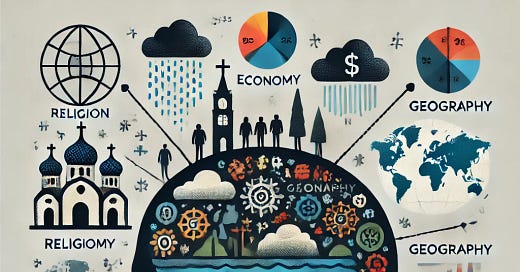Introduction
Our last series of essays explored the following three primary facets of human life related to spiritual health: meaning-making, life purpose, and awareness of well-being. If you haven’t already, I hope you will take the time to read them, as this will help you get a feel for where we are headed in today’s essay. In this essay, we will explore how culture shapes an individual’s ideas and attitudes about what it means to live a good life, and how this impacts one’s spiritual health.
The Idea of Living a Good Life
If you were born in the year 1900 and raised in the Borena region of Ethiopia, what would a good life look like? How about present-day South Korea? What about North Korea? Or in various parts of Europe and North America? Going back two hundred years to 1825, how would the concept of a good life in these areas compare to 2025? Each of these regions carries particular cultural, economic, and geographic pressures that effect how one makes decisions on how to live a good life.
In the United States, since its inception, the idea of living a good life is tied to notions about individual freedom and the inherent, God-given right to life, liberty, and the pursuit of happiness. In present-day America, personal achievement and self-actualization are key markers to the fulfillment of living a good life. It’s likely this idea will continue to remain a powerful cultural norm that impacts one’s notion on how to live a meaningful life.
In contrast, today’s more orthodox Islamic societies in places like the Middle East, North Africa, South Asia, and Southeast Asia, emphasize different ideas about what it means to live a good life. Core Islamic values—obedience, surrender to God, family responsibilities, social justice, and charity—shape individuals’ understanding about living a good life. The Qur’an, Islam’s sacred text, places these ideas and values at the forefront of one’s life, compelling individuals to see themselves primarily in relation to societal and family duties.
Other places where Islamic communities are growing—such as Europe, North America, and Latin America—experience a more diverse and nuanced approach between their faith practice and the Western ideals and values of individualism, democracy, and human rights.
Where Do Your Beliefs and Values Come From?
No one is the sole arbitrator of their personal beliefs and values. If you live in America, you might think your current ideas and beliefs about how to live a good life are the result of autonomous, free, individual choices. However, I find this notion questionable at best. No one escapes the hidden cultural influences that help shape our views and attitudes about self and how to live a fulfilled life.
Swimming in a Sea of Ideas and Attitudes
A fish swimming in the ocean is unaware of many elements that make its survival possible—salt concentration, oxygen levels, and pH balance, to name a few. Similarly, individuals living in the United States (and elsewhere) are often unaware of invisible cultural forces that shape their attitudes and concept about the meaning of a good life.
Just like a patient wants to get to the bottom of the cause and source of their undiagnosed disease, we want to dive deeper to see what kind of hidden values and beliefs have been shaping our decisions and attitudes about living a fulfilled life.
Conclusion
In our next series of essays, we’ll explore three primary factors influencing our current understanding of what it means to live a good life: beliefs, attitudes, and values.
Until next time—Here’s to your spiritual health!!





Interesting. Is there a difference between a "good" life and a "fulfilled" life?
great read!